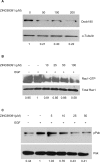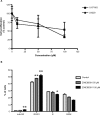Proapoptotic and antiinvasive activity of Rac1 small molecule inhibitors on malignant glioma cells
- PMID: 25378937
- PMCID: PMC4218912
- DOI: 10.2147/OTT.S67998
Proapoptotic and antiinvasive activity of Rac1 small molecule inhibitors on malignant glioma cells
Abstract
Malignant gliomas are characterized by an intrinsic ability to invade diffusely throughout the normal brain tissue. This feature contributes mainly to the failure of existing therapies. Deregulation of small GTPases signaling, in particular Rac1 activity, plays a key role in the invasive phenotype of gliomas. Here we report the effect of ZINC69391, a specific Rac1 inhibitor developed by our group, on human glioma cell lines LN229 and U-87 MG. ZINC69391 is able to interfere with the interaction of Rac1 with Dock180, a relevant Rac1 activator in glioma invasion, and to reduce Rac1-GTP levels. The kinase Pak1, a downstream effector of Dock180-Rac1 signaling, was also downregulated upon ZINC69391 treatment. ZINC69391 reduced cell proliferation, arrested cells in G1 phase, and triggered apoptosis in glioma cells. Importantly, ZINC69391 dramatically affected cell migration and invasion in vitro, interfering with actin cytoskeleton dynamics. We also evaluated the effect of analog 1A-116, a compound derived from ZINC69391 structure. 1A-116 showed an improved antiproliferative and antiinvasive activity on glioma cells. These findings encourage further preclinical testing in clinically relevant animal models.
Keywords: Dock180; GTPases. invasion; small molecule.
Figures






References
-
- Maher EA, Furnari FB, Bachoo RM, et al. Malignant glioma: genetics and biology of a grave matter. Genes Dev. 2001;15(11):1311–1333. - PubMed
-
- Giese A, Bjerkvig R, Berens ME, Westphal M. Cost of migration: invasion of malignant gliomas and implications for treatment. J Clin Oncol. 2003;21(8):1624–1636. - PubMed
-
- Etienne-Manneville S, Hall A. Rho GTPases in cell biology. Nature. 2002;420(6916):629–635. - PubMed
-
- Rossman KL, Der CJ, Sondek J. GEF means go: turning on RHO GTPases with guanine nucleotide-exchange factors. Nat Rev Mol Cell Biol. 2005;6(2):167–180. - PubMed
LinkOut - more resources
Full Text Sources
Other Literature Sources
Research Materials

